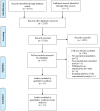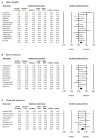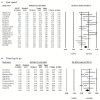Effects and Moderators of Exercise on Sarcopenic Components in Sarcopenic Elderly: A Systematic Review and Meta-Analysis
- PMID: 34095166
- PMCID: PMC8169963
- DOI: 10.3389/fmed.2021.649748
Effects and Moderators of Exercise on Sarcopenic Components in Sarcopenic Elderly: A Systematic Review and Meta-Analysis
Abstract
Background: Sarcopenia is a muscle disease in loss of muscle strength, mass, and function associated with aging. Although protective effects of exercise on muscle mass and function are generally recognized, research findings in sarcopenic adults are inconsistent. It is necessary to conduct a systematic review to determine the effects of exercise on muscle strength, body composition, and physical performance in older adults with sarcopenia, and to examine the potential moderators including sociodemographic characteristics and exercise-related factors. Methods: Six electronical academic databases (Medline, Embase, CINAHL, Scopus, Cochrane Library, and SPORTDiscus) were used to retrieve the eligible studies from inception to May 2020. Two reviewers independently selected and extracted the data from each included study, and effect sizes were calculated by employing random-effect models with 95% confidential interval (CI). The Physiotherapy Evidence Database (PEDro) scale was used to assess study quality. Results: Seventeen studies (985 participants with sarcopenia, aged 67.6-86 years) were included in this review study. The meta-analytic results showed significant improvements in muscle strength [grip strength, SMD = 0.30, 95% CI (0.15, 0.45), I 2 = 6%, p < 0.01; knee extension, SMD = 0.32, 95% CI (0.15, 0.50), I 2 = 0%, p < 0.01; and chair and stand, SMD = 0.56, 95% CI (0.30, 0.81), I 2 = 36%, p < 0.01], in physical performance [timed up and go, SMD = 0.74, 95% CI (0.48, 1.00), I 2 = 0%, p < 0.01; and gait speed, SMD = 0.59, 95% CI (0.35, 0.82), I 2 = 62%, p < 0.01], and in body composition [skeletal muscle mass index, SMD = 0.37, 95% CI (0.15, 0.58), I 2 = 16%, p < 0.01; and appendicular skeletal muscle, SMD = 0.31, 95% CI (0.13, 0.49), I 2 = 20%, p < 0.01]. However, there were no significant differences in other body composition (SMD = 0.20-0.36). Additionally, meta-regression revealed that the higher percent of female participants was significantly associated with improved gait speed (β = 0.0096, p = 0.03) and decreased skeletal muscle mass index (β = -0.0092, p = 0.01). Conclusions: The current meta-analysis suggests that exercise is a beneficial therapy, which has protective effects for older adults with sarcopenia. Some beneficial effects may be moderated by gender and exercise intensity.
Keywords: meta—analysis; muscle function; physical exercise; physical performance; sarcopenia.
Copyright © 2021 Zhang, Zou, Chen, Bae, Kim, Liu and Song.
Conflict of interest statement
The authors declare that the research was conducted in the absence of any commercial or financial relationships that could be construed as a potential conflict of interest.
Figures






Similar articles
-
Effects of exercise with or without β-hydroxy-β-methylbutyrate supplementation on muscle mass, muscle strength, and physical performance in patients with sarcopenia: a systematic review and meta-analysis.Front Nutr. 2024 Sep 18;11:1460133. doi: 10.3389/fnut.2024.1460133. eCollection 2024. Front Nutr. 2024. PMID: 39360288 Free PMC article.
-
Exercise Programs for Muscle Mass, Muscle Strength and Physical Performance in Older Adults with Sarcopenia: A Systematic Review and Meta-Analysis.Aging Dis. 2020 Jul 23;11(4):863-873. doi: 10.14336/AD.2019.1012. eCollection 2020 Jul. Aging Dis. 2020. PMID: 32765951 Free PMC article. Review.
-
The Effects of Different Exercise Training Types on Body Composition and Physical Performance in Older Adults with Sarcopenic Obesity: A Systematic Review and Meta-Analysis.J Nutr Health Aging. 2023;27(11):1076-1090. doi: 10.1007/s12603-023-2018-6. J Nutr Health Aging. 2023. PMID: 37997730
-
Effects of Exercise Programs in older adults with Muscle Wasting: A Systematic Review and Meta-analysis: Effects of Exercise Programs in Muscle Wasting.Arch Gerontol Geriatr. 2022 Mar-Apr;99:104605. doi: 10.1016/j.archger.2021.104605. Epub 2021 Dec 2. Arch Gerontol Geriatr. 2022. PMID: 34922244
-
Effects of resistance training in healthy older people with sarcopenia: a systematic review and meta-analysis of randomized controlled trials.Eur Rev Aging Phys Act. 2021 Nov 11;18(1):23. doi: 10.1186/s11556-021-00277-7. Eur Rev Aging Phys Act. 2021. PMID: 34763651 Free PMC article. Review.
Cited by
-
The Effectiveness of a Group Kickboxing Training Program on Sarcopenia and Osteoporosis Parameters in Community-Dwelling Adults Aged 50-85 Years.Front Med (Lausanne). 2022 Apr 25;9:815342. doi: 10.3389/fmed.2022.815342. eCollection 2022. Front Med (Lausanne). 2022. PMID: 35547204 Free PMC article.
-
Physical Activity Improves Cognition and Activities of Daily Living in Adults with Alzheimer's Disease: A Systematic Review and Meta-Analysis of Randomized Controlled Trials.Int J Environ Res Public Health. 2022 Jan 22;19(3):1216. doi: 10.3390/ijerph19031216. Int J Environ Res Public Health. 2022. PMID: 35162238 Free PMC article.
-
Are There Differences in Postural Control and Muscular Activity in Individuals with COPD and with and Without Sarcopenia?Adv Respir Med. 2025 Feb 18;93(1):5. doi: 10.3390/arm93010005. Adv Respir Med. 2025. PMID: 39996622 Free PMC article.
-
Multicomponent intervention to prevent mobility disability in frail older adults: randomised controlled trial (SPRINTT project).BMJ. 2022 May 11;377:e068788. doi: 10.1136/bmj-2021-068788. BMJ. 2022. PMID: 35545258 Free PMC article. Clinical Trial.
-
Resistance Training and Nutritional Supplementation in Older Adults with Sarcopenia after Acute Disease: A Feasibility Study.Nutrients. 2024 Sep 10;16(18):3053. doi: 10.3390/nu16183053. Nutrients. 2024. PMID: 39339653 Free PMC article.
References
Publication types
LinkOut - more resources
Full Text Sources
Medical

